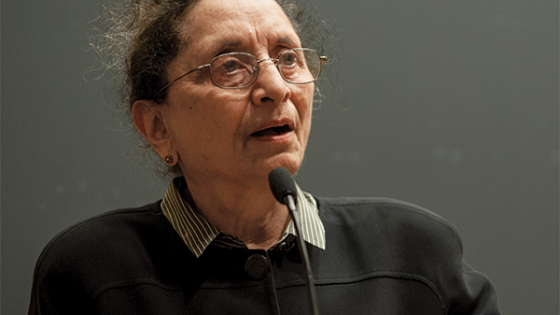Ronald Coase, who passed away last week at the age of 102, left an indelible mark on both economics and law. In 1991 he was awarded the Nobel Memorial Prize in Economic Sciences in recognition of his work on transaction costs and property rights. Best known for the ‘theorem’ that bears his name, the depth and breadth of Coase’s contributions are decidedly under-appreciated by the economics community – in no small part because his methodological approach and the subjects to which it led him differed from those that dominated the profession after WWII.
A wide-ranging and influential academic career
Coase took a degree in Commerce at the LSE in 1932, and thereafter occupied academic posts at Dundee, Liverpool, LSE, Buffalo, Virginia, and Chicago – the term at LSE being interrupted by six years of government service during and immediately after WWII. His lack of formal training in economics accounts for much of his unique approach to economic analysis – he eschewed formalism and instead emphasised a combination of case studies and intuitive price-theoretic analysis. Coase is the only Nobel laureate in economics whose corpus of work includes no equations.
While “The Nature of the Firm” (1937) and “The Problem of Social Cost” (1960) are by far the best-known of Coase’s contributions – indeed, the only articles of his that many economists could name – his published writings are both extensive and wide-ranging. He examined problems in areas including accounting practices, advertising, public goods, consumer surplus, public utility pricing, monopoly theory, blackmail, the economic role of government, and the history of economic thought. What unites these disparate works is a focus on what Coase called “the institutional structure of production”. Coase was primarily concerned with the role played by institutions – in particular the firm, the market, and the law – in economic structure and performance.
The most influential of Coase’s early works, “The Nature of the Firm” (1937), set out to explain why firms exist and what determines the extent of a firm’s activities. This article is now suitably famous for highlighting the role played by transaction costs – the relative costs of internal and market organisation – in determining the organisation of the firm. Coase’s insight was developed at much greater length and in various directions by Oliver Williamson, Armen Alchian, Harold Demsetz, and others many decades later.
Case studies and the comparative institutional approach
While “The Nature of the Firm” looks to the modern eye like a standard set of deductions using elementary price theory, it actually developed out of a lengthy period examining business practices during a visit to the US while Coase was a student at LSE. This same approach characterises Coase’s lengthy series of historical studies of public utilities – a subject that occupied much of the middle third of his career. The most important of these was his work on British broadcasting, a massive study that analysed the development of wireless and wire radio broadcasting, television broadcasting, and the rise of the BBC as the monopoly broadcaster (1950, 1954).
Another of these studies, on the British Post Office, examined the rise of the penny postage in the UK under Rowland Hill, and the attempts by the Post Office to enforce its monopoly against incursions by private entrepreneurs, including the messenger companies (e.g. 1955). Each of these projects highlights the insights to be gained from the messy, detailed case studies of which Coase was so fond, and they also signal his concern with monopoly in general and state monopoly in particular.
Coase’s interest in broadcasting policy eventually led him to examine, following his migration to the US, the process by which the Federal Communications Commission regulated the broadcast frequency spectrum (1959). This study ultimately led to the publication of what is almost certainly Coase’s most famous paper – “The Problem of Social Cost” (1960). Though best known for the negotiation result that George Stigler (1966, p. 113) later codified as the ‘Coase theorem’, the article’s central focus was a much more broad-based attempt to dismantle the dominant Pigouvian approach to the analysis of externalities.
Real-world imperfections in markets and governments
Coase’s negotiation result demonstrated that, under standard neoclassical assumptions, Pigouvian remedies for externalities are unnecessary. Costlessly functioning markets, like the costlessly functioning governments of Pigouvian welfare theory, will generate efficient outcomes. The problem, as Coase emphasised, is that both market and government coordination are costly, and neither will generate the optimal solutions contemplated by economic theory. Society thus faces a choice among imperfect alternatives and this, in turn, necessitates the adoption of a case-by-case, comparative institutional approach to the problems of economic policy.
Coase was convinced that economists had been too quick to advocate government controls in situations of ostensible market failure, and had underestimated what markets could achieve. His work on the Federal Communications Commission – where he advocated the allocation of frequencies via the market – and on the provision of lighthouse services – where he found that the private sector had played a significant historical role – showed markets could work reasonably well in situations where economists assumed they could not.
Coase was also concerned to demonstrate the inadequacy of the Pigouvian approach to public policy analysis. Although his emphasis on transaction costs meant he placed little faith in ‘Coase theorem’-type solutions to externality problems, Coase nevertheless believed that the status quo might be the best we can do. When the real-world costs of government are taken into account, it may be more efficient to do nothing about the ‘problem’, because the governmental cure may be worse than the market disease.
Against ‘blackboard economics’
Coase’s criticisms of the theory of economic policy were part of a larger critique of what he often referred to as ‘blackboard economics’ – an economics where curves are shifted and equations are manipulated, with little attention to the correspondence between the theory and the real world, or to the institutions that might bear on the analysis. A similar set of concerns led to his scepticism about the application of economic analysis beyond its traditional boundaries. Contrary to popular misperception, Coase had precious little interest in the economic analysis of law. Instead, Coase’s ‘law and economics’ was concerned with how law affected the functioning of the economic system.
It is ironic, then, that the idea most closely associated with Coase, the ‘Coase theorem’, is in many respects the height of ‘blackboard economics’ and a cornerstone of the economic analysis of law. Being misunderstood was something of a hallmark of Coase’s career, as he pointed out on any number of occasions. We should all be so fortunate.
Bibliography
Coase, R H (1937), “The Nature of the Firm”, Economica 4(16): 386-405.
Coase, R H (1950), British Broadcasting: A Study in Monopoly, London and Cambridge, MA: Longmans Green and Harvard University Press.
Coase, R H (1954), “The Development of the British Television Service”, Land Economics 30: 207-222.
Coase, R H (1955), “The Postal Monopoly in Great Britain: An Historical Survey”, in J K Eastham (ed.), Economic Essays in Commemoration of the Dundee School of Economics, 1931-55, Dundee: W. Culross: 25-37.
Coase, R H (1959), “The Federal Communications Commission”, Journal of Law and Economics 2: 1-40.
Coase, R H (1960), “The Problem of Social Cost”, Journal of Law and Economics 3: 1-44.
Medema, S G (1994), Ronald H. Coase, London and New York: Macmillan and St. Martin’s Press.
Medema, S G and R O Zerbe, Jr. (2000), “The Coase Theorem”, in Boudewijn Bouckaert and Gerrit De Geest, (eds.), The Encyclopedia of Law and Economics, Aldershot: Edward Elgar Publishing: 836-92.
Stigler, G J (1966), The Theory of Price, 3rd ed., New York: Macmillan.
A comprehensive list of Coase’s publications can be found at: http://www.coase.org/coasepublications.htm


